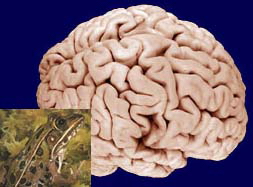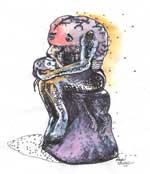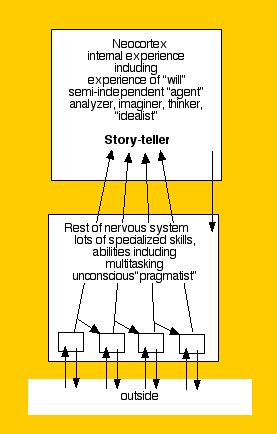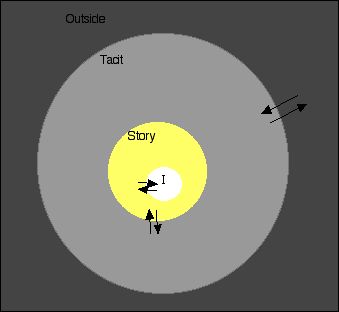Serendip is an independent site partnering with faculty at multiple colleges and universities around the world. Happy exploring!
Brain Behavior Institute - Session 13
|
|

|
BRAIN AND BEHAVIOR INSTITUTE 2008 |

|
Architecture: From the Input Side
Review: a shifting perspective, the cognitive unconscious and the I-function -> story teller Actions and reactions in our students, as they use their cognitive
unconscious, seems to imply that maybe they don't have control of their
basic self(instincts). I think the cognitive unconscious and the
neocortex(I function) need a healthy balance. Is there one? How do we
enable our students to create and be productive along with fitting in
with what society demands?.... Or should we want to? ... Judith
On boxes in the cognitive unconscious: isn't is true that there is not
such thing as a 'bad' box? All the 'boxes' are doing is trying to help
us survive as an organism, so their conflict with each other is not
bad, even though it certainly can cause some negatative consequences,
and their action needs to be 'managed'. However, these boxes, these
drives are what keep us alive and so should be respected! ... As for application to kids: when we see 'bad' behavior, I think we view
it the same way; as the organism's/student's best attempt to survive in
its system, even if it is a misguided and dysfunctional attempt ... Carol
As a student, who has had an ineresting set if
experiences, I can say that sometimes my actions or responses
must seem ridiculous to my teachers. If only they could
understand what is going on with my brain. Or at least, for
privacy's sake, admit that there might be something significant
happening in my head ... Julia
The I-Function and the cognitive unconscious seem to work helping one
another. Although no one box is in charge they effect one another and
work together ... Seta
Actions and reactions in our students, as they use their cognitive
unconscious, seems to imply that maybe they don't have control of their
basic self(instincts). I think the cognitive unconscious and the
neocortex(I function) need a healthy balance. Is there one? How do we
enable our students to create and be productive along with fitting in
with what society demands?.... Or should we want to? ... Judith
On boxes in the cognitive unconscious: isn't is true that there is not
such thing as a 'bad' box? All the 'boxes' are doing is trying to help
us survive as an organism, so their conflict with each other is not
bad, even though it certainly can cause some negatative consequences,
and their action needs to be 'managed'. However, these boxes, these
drives are what keep us alive and so should be respected! ... As for application to kids: when we see 'bad' behavior, I think we view
it the same way; as the organism's/student's best attempt to survive in
its system, even if it is a misguided and dysfunctional attempt ... Carol
As a student, who has had an ineresting set if
experiences, I can say that sometimes my actions or responses
must seem ridiculous to my teachers. If only they could
understand what is going on with my brain. Or at least, for
privacy's sake, admit that there might be something significant
happening in my head ... Julia
The I-Function and the cognitive unconscious seem to work helping one
another. Although no one box is in charge they effect one another and
work together ... Seta the first task that educators have at the beginning of the school year is to discover the qualities embedded in the students they are going to work with (not teach) for that particular year and take advantage of it rather than suppress it ... Tunde After taking B&B last year, I occasionally felt (saw?) the course information ping-pong around my cognitive subconscious while I was teaching my high school students. It was as if these B&B connections would rise to the top of my awareness like air bubbles that would disappear when other priority tasks would pop them. However as I take the course again this year I am finding that my cog/sub is able to offer not only the information that I took in last year but that I am also able to remember the same connections that partially floated to the surface while teaching in the past year.
Without the distractions am I now able to pull my I-function into play and actually formulate new ideas about the series of connections? ... Joyce
More thoughts on "society of mind" ... Paul
From the examples we discussed today, they all involved motor units. How does the neocortex inhibit patterns in parts of the brain to allow learning? ... PennNew principles from the input side
- Multiple inputs, unconscious/"I-function" distinction
- Brain "making things up" (see BBI05 and BBI05 with I-function help)
- Built in presumptions of "reality"
- Ambiguity as fundamental
- Testing and retesting, negotiating and renegotiating - all unconscious, doesn't worry about "Truth" or "Reality", just comes up with something that works - "story"
- The "crack"
- Different for different people
- Again an unconscious/"I-function" distinction in abilities/uses
- Perception an exploratory process, testing and retesting
- Using both unconscious and I-function

- From I-function to "story teller", and story creator (making what hasn't been seen)
- "Self" as story
- Using both unconscious and I-function
- Input is always incomplete (and affected by output)
- Input is always interpreted based on prior information (including genetic information)
- Input is always ambiguous
- Interpretation is improved (but not completed) by combining multiple perspectives, resolving conflicts
- Both input and interpretation are different for different people
- What we see is a "story" reflecting unconscious processes
- "Reality" is a collective story, reflecting (desirably) the different perspecties of different people
- Stories can in turn generate new questions/observations/stories, and new stories (that in turn ...)



Comments
I just have to post this
Please read this NYT article and, after experiencing the Brain and Bhavior institute, tell me if you also reacted in more ways than one.
For those who have not, this article is just as valuable to read because it touches on the increasingly horrible treatment of mentally different students in public schools.Concerns regarding "mainstreaming" students with special needs (not to mention of all different kinds of students) and its effectiveness and safety are very high. Please also take a look at the on-going conversation here on serendip about these diversity issues associated with education.
Subtle changes=Big differences.....
.....--> The Brain and Behavior
One implication that arises from the non-linear fashion in which our Nervous System works can be found in a student’s indifference in the practice of learning or behaving in school which may have origins outside of the peripheral. There may very well be an underlying reason (whether neurological, social, etc.) causing the unanticipated student behavior that teachers, administrators, and parents alike need to consider BEFORE diagnosing and/or dismissing a child’s particular behavior. (Thank you Tola) Although a subtle difference in mentality, this change can definitely create positive results in better accommodating a student’s style of/ learning.
HELLO FROM DUKE
Hello Everyone!
My name is Ashley Dawkins and I helped out with the Institute last summer. I am at Duke for grad school right now. I will be getting an M.A.T. and will be certified to teach high school physics and math by next summer. I am writing to tell all of you about a book I am reading for the educational psychology class I am currently taking. It's called Secrets of the Teenage Brain by Feinstein. I have found it to be an interesting read and relevant to want you guys are learning about with Paul.
Best,
Ashley
Thank you
speaking of compliance
Generating Learning Opportunities
Hard to believe but for me, a lunch discussion initiated important connections involving student learning. Tunde described an incident where he definitely perceived the traffic light to be green and passed through the intersection hearing squealing brakes around him but without calamity. He said he was thinking of other things (as we all do), therefore when he felt the car (in the right-perpendicular) lane slow down he, as on cue, looked at the traffic light and ‘saw’ green.
We can all relate to this experience because our I-function is often involved in our prioritized topics while we simultaneously perform other tasks in remote control. Long distance driving is especially boring so our I-Function immediately launches interesting scenarios to keep us entertained. Meanwhile our cognitive unconscious is driving the car. As we heard Paul explain today the cog/unconscious will generate a prediction based on a very sophisticated set of genetic and experiential ‘traces’. Therefore when Tunde’s cog/unconscious became aware of car slowing down; Tunde received the perception “green” that matched “slowing down”. When he heard the brakes squealing; Tunde’s I-function immediately kicked in gear and he was nervously aware of his mistake.Connecting to student learning, we know that students shuffle into our classrooms with only their cognitive unconscious in operation. Like Tunde they will immediately respond to a set of operational behaviors.
Get out notebook…copy anything on the whiteboard…raise hand…say usual responses…etc.
Knowing the behavior of the cognitive unconscious how can teachers both wake up students’ I-Function and initiate student learning?
See Joyce's BlogThe myth of "self-control"
We were shown this morning that some behavior exhibited by students may not be under their conscious control. This leads us to not say to a student, "How
can you not know what you did?!" It very well might be that the action
was done by the cognitive unconscious without the knowledge or control by the student's "I-function." It forces me as the teacher to approach control and discipline from a totally different angle. It remains to be seen how well I will be able to develop and employ new techniques to address this new understanding. I guess this will be one of the areas I'll be reporting on during the year.
Reflection - Input
Ambiguity in the classroom
The discussion this morning gives me an impression that I will be a different teacher when I get back to school in September. The way I am looking at it, I will not approach my students' behaviors the way I used to because now I know better that they may not see what I think they are seeing. Their brains or mine could be playing tricks on us as regards reception and interpretation of AMBIGOUS INFORMATION.
Imagine children with dyslexia but who have not been officially identified. Such students will be having a real hard time doing what I ask them to do in class because they see it all differently. Using the example of the optical illusion that I was using to teach my Sunday school class that the miracles of Jesus are real, one can safely say that what you see is not real. This is because the brain is actually making up its own informed guess using signals received by the cognitive unconscious.
With all said and done, won't this become a solid platform to make excuses for students who do not do what is expected of them in my class? If I ask students to do a page for homework and one comes in the next day and tells me he forgot or did not hear me, I probably will just let it slide now. Normally I would have him do it in place of recess and after 3 occurrences will call his parents as a form of punishment. Now I know better.
The other thing I am seriously considering is diffentiated instruction in my classroom. In view of the fact that everyone sees things differently, I have to make accommodations for every student as close to meeting their needs as possible.
It is going to be a whole new ball game in my class now.
Tola
reality is a hallucination?
So, Paul and I were refining our story of reality and came up with this..."reality is a consensus hallucination about that which cannot be known." It follows that in can only be understood in terms of the constructed language of the mass hallucination.
For me the fact that we are constructing a hallucination means there is something "back there" that we are trying to explain. By this line of reasoning, God cannot be understood, is that which cannot be known or spoken of, hence God must also be "back there"?
As one who moves from agnosticism, atheism, pantheism and then back again in search of a consistent story, I find that I have argued my way into believing in God, if I believe in reality. Interesting.
Anyone have any thoughts that may bare on this particular hallucination?
reality = that of which we cannot speak ?
Actually, the phrasing I wrote down is a little different
Reality is a collective hallucination about things of which we cannot speak
What's significant here is not that there are things "which cannot be known," with the attendent implication that there is "back there" somewhere an unknowable. It is rather that the "out there" cannot in principle be captured in any particular set of words.
What's being called attention to here (courtesy of Wittgenstein ... "What we cannot speak of we must pass over in silence") is not an unknowable thing but rather a limitation inherent in language, and probably in inquiry in general. If all understandings/stories are inevitably perspective dependent, then there is no way to provide a definitive description of what is out there, ie a description that is perspective free is unachievable. And a "hallucination" is not defined as something one sees that is different from "reality" but rather as anything one sees that is known to be perspective dependent or "constructed" (which is to say, on the present argument, everything that is or will be seen). We are in these terms all "hallucinating," all the time, and always will be.
An amusing thought experiment motivated by a student question in a class of mine last semester may help to clarify all this. Supposing one eliminated all of the known "constructions" that the brain is using to yield what we see? What would "out there" look like in the absence of any of those constructions? The answer is probably something like this. What the brain seems to be doing is detecting and giving meaning to small statistical regularities in noise. The regularities are ONLY statistical and have no meaning in themselves. On this line of thinking, there is no meaning out there unless and until we give it meaning. And hence no description of the "out there" other than "noise" (or "chaos"), ie there is no "meaningful" description except one provided by a meaning-maker (of which the brain is one).
Recognizing this, Wittgenstein's advice is that we remain silent about "reality." An alternative suggestion that appeals to me more was made by Nelson Goodman who said "The answer to the question "What is the way the world is? What are the ways the world is?" is not a shush, but a chatter." Goodman's notion is that the absence of a describable reality shouldn't cause us to stop inquiring but instead encourage us to make candidate meanings in lots of different ways and share them to see what new meanings they in turn create.
We'll talk more about this tomorrow, but that notion of creative and collective meaning making seems to me not a bad way to think of the educational process ... and of life in general. We're not looking for "reality" but rather engaging in any on going and shared process of creating less wrong hallucinations.
Revisiting the notion of reality
I remember I was told a student on my list for Sept 2008 has ADHD etc. His 3rd grade teacher told me he never sits in the class, runs around in the hallways and gets suspended every other week or so. To her he is impossible. On the other hand his science prep teacher who gets him 3X a week for 45 mins each time, claims he is not as active in her class but likes to be hands-on.
I see two strengths: he is creative, artistic and loves to run errands. An advantage is that he has a TSS worker. I am thinking of a plan of action for this student.
I normally put up the works that my children do on bulletin boards every month or so. My plan is to have him do this for me. He will put the works up in creative and decorative ways, create a caption etc. With this he will be able to walk in the hallways but with an aim and my permission. He will be learning as he sees and handles the works of other students:faith cometh by hearing and seeing too :) He will get to create his own stuff and get to be a helper running errands. His TSS will be with him. I pray this works and hopefully the administrator will allow it.
With this the student's reality and my reality will merge to create a less wrong experience for both of us.
Perceived Tapestry
Evolution of the Brain
A discussion with Will generated an interesting thought process for me.
Perhaps whether or not this most sophisticated link creates a better or worse situation for the species becomes the consequence of eventual collective accord.
Today's class made me feel
Morning Session Real vs Reality?
Reality vs Reality
The conflict arises when two realities (our students and ours) are in conflict. If there is going to be any meaningful and productive outcome from all our efforts for the school year, both realities according to Judith must gravitate towards a consensus. Anything contrary to this will be disastrous.
I think there has to be a consideration for my reality to influence my students' realities to an extent in view of the fact that I'm an adult and that I have more experience in life. Subsequently I see myself taking better and more informed decision than them.
There has to be an advantage for putting teachers in the classroom due to the fact that they have passed through the same experience students are now passing through.
I like to think the notion
education implications
Originally posted elsewhere by GMH ...
As the story goes, what we see as teachers in a classroom needs to be questioned and tested by comparing what is percieved with others. Our brain's informed guess of "reality" being an approximation created by the cognitive unconsciousness interacts with other people in a social context.The need for self reflection as one teaches is an vital component of making meaning out of what we perrcieve in our students behavior. Finding time for this is important. So too is making time for sharing perspectives with other teachers.
The notion that we can always get it less wrong is freeing.
Re-education implications
As you mentioned here, I have been thinking about how all these will fit like puzzle pieces in my being as an educator. I am considering an overhaul of my best practices to make room for my students' perspectives too. Also, I believe that my students are going to feel very much blessed because they will be getting a teacher that will give them the flexibility in an environment that will allow them to learn differently and individually.
One thing is that it will be difficult for teachers who have not been part of this institute to make sense of what we have done here. It will take time and evidence {seeing it work in my class} for them to believe. I wish this could be made available to all teachers.
Together we will be getting it less wrong.
thoughts on Paul's teaching
I just realized why I can't teach like Paul; not only because I don't know as much as he does, which I don't, but because he is an incredible story teller, and I have never been a good story teller. A good story has suspense, tension, ambiguity, confusion and slowly builds to the end. It requires being patient and being able to tolerate fuzziness and unclarity. I want to know how it ends. I like clarity. I'm uneasy with confusion. I never could make up stories to tell my children, but I loved reading books to them. I like things organized.
Back to this morning, I recognize that we are all storytellers. Our brains are wonderful at constructing useful realities that allow us to survive and thrive in this world. I also recognize that creativity is probably related to how good storytellers we are. I've been interested in understanding what genius is; in figuring out what intelligence is. It may well be, in this model, that genius and intelligence is a measure of the type of storyteller that we are. I wonder, then, can intelligence be taught? Can we teach kids to be better story tellers, to come up with better stories? I know the answer must be yes.
More later once my brain processes all this a bit more---
Another potential criteria
Post new comment